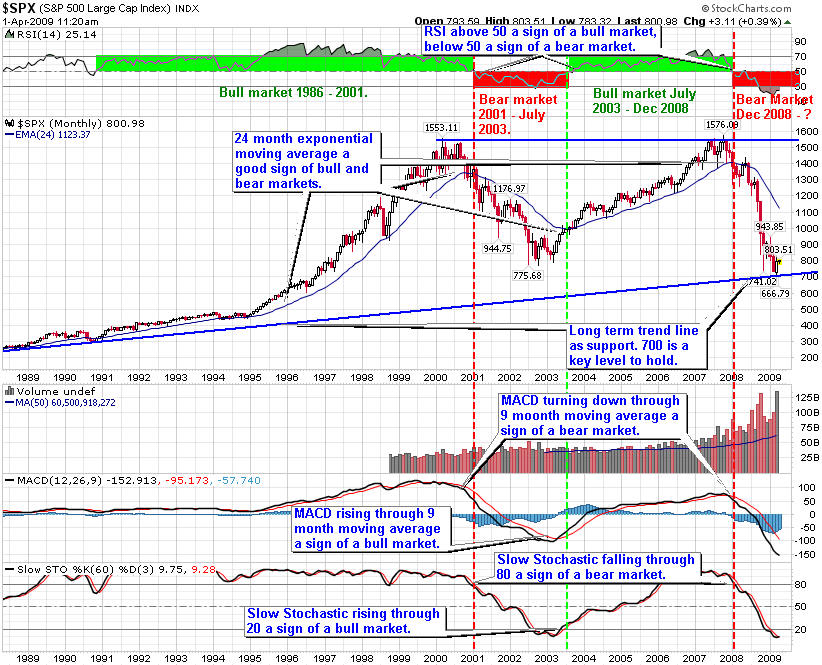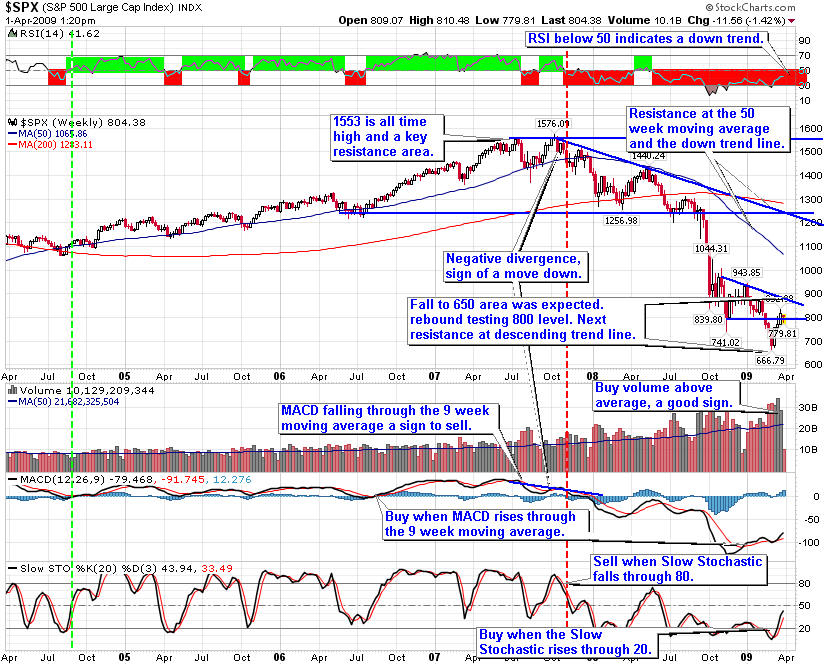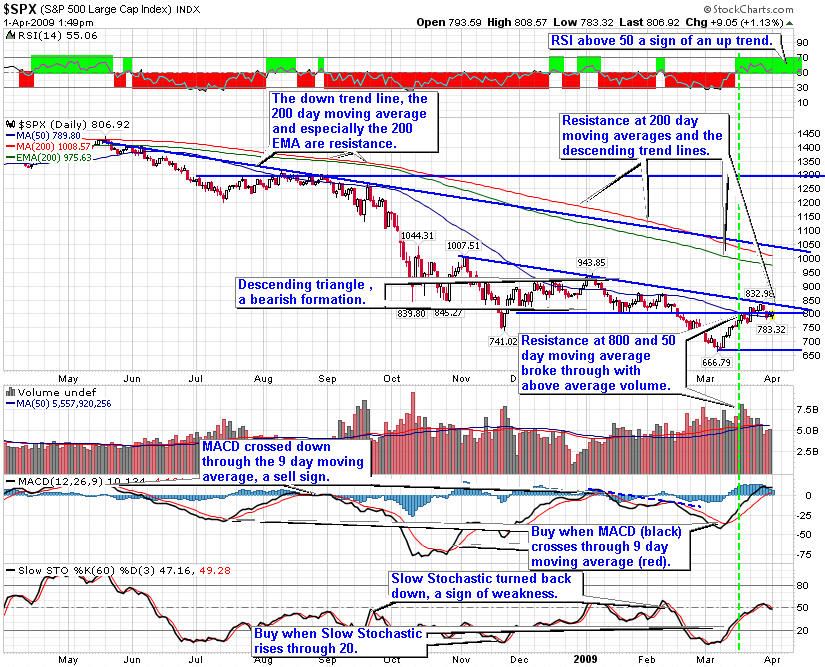Stock Market Trends for April 2009- The Bear Market Rally
Stock-Markets / Stocks Bear Market Apr 04, 2009 - 02:47 AM GMTBy: Hans_Wagner

 Analyzing monthly stock market trends uses the S&P 500 charts to indicate important trend lines. Trend following is a proven strategy to beat the market and grow your stock portfolio. Technical analysis provides the tools to analyze and identify trends in the stock market. Since the S&P 500 trend line chart is the one used by professional traders for their analysis, it is important to understand how it is performing.
Analyzing monthly stock market trends uses the S&P 500 charts to indicate important trend lines. Trend following is a proven strategy to beat the market and grow your stock portfolio. Technical analysis provides the tools to analyze and identify trends in the stock market. Since the S&P 500 trend line chart is the one used by professional traders for their analysis, it is important to understand how it is performing.
The analysis of the S&P 500 trend line starts with the 20-year monthly view of the S&P 500 chart. Next, we examine the weekly chart of the S&P 500 trends to get a shorter-term view. Finally, we analyze the one-year daily chart of the S&P 500 trends to get an even shorter-term view. On each version of the charts of the S&P 500 trend line, the view and the value of the indicators change, as we move from a monthly to a weekly and then a daily chart.
Starting with the monthly view of the S&P 500 trend chart, the bull market of the last five years turned down, as the index fell below the 24-month exponential moving average. The Relative Strength Indicator (RSI) is below 50, indicating a downtrend is in place. The Moving Average convergence Divergence (MACD) is also below zero, a sign stock market trend has reversed and we have entered a bear market. Finally, the Slow Stochastic fell through zero, another sign of a bear market.
The analysis of the monthly trends of the S&P 500 chart shows we remain in a bear market with key resistance at the 24-month exponential moving average. In addition, support at the 25 year rising S&P 500 trend line has been tested and held, so far.

The three-year weekly S&P 500 trend line chart shows more closely the transition from a bull to a bear stock market. So far, the descending trend line and the 50-week moving average are the primary resistance levels for this view of the bear market.
As expected, the trend of S&P 500 chart fell through support at the 800 level and fell to the 650 area. The S&P 500 trend then reversed course and is trying to push back through the 800 level, which is acting as resistance. The next important level is the small descending trend line at the 850 area. From the chart, it looks like the S&P 500 trend line will continue to rise through these resistance levels and test the 50-week moving average. It will be a number of weeks before we see a test of the 50-week moving average.
RSI is below 50 indicating a downtrend remains in place. The MACD turned up through the nine-week moving average, a buy sign and it is still trending up, which is a positive sign. Slow Stochastic turned up through 20, a sign the trend on the S&P 500 chart will continue to move up.
Long term, the trend line of the S&P 500 chart is still down. The weekly pattern indicates that we turned up after falling to the 650 level. For now, the chart of the S&P 500 trend line indicates the most likely case is we will see a test of the 50-week moving average.

The daily S&P 500 trend line chart demonstrates how a measured move predicated by the descending triangle worked as expected. A measured move is a way technicians determine a price target based on a technical pattern. For a descending triangle, the price target is equal to the height of the triangle after a break of support. The top of the descending triangle on the S&P 500 trend line chart is 1,000 and the base is 800, resulting in a height of 200. Subtract 200 from the base of 800 gives you a price target of 600 on the S&P 500 trend chart. This meant we were likely to see the trend on the S&P 500 chart fall to the 600 - 650 level before it turns up. The S&P 500 fell to just above the 650 level and then turned up.
Presently, the S&P 500 is trying to push through resistance at the 50-day moving average, the 800 level and the descending trend line at the 840 level. These important resistance levels may take some time to get through. Watch for above average buying volume as a sign the S&P 500 will continue its up trend.
RSI is above 50 indicating an up trend. The MACD turned up through the nine-day moving average, a buy sign. Watch to see if it continues to trend up. The slow stochastic turned up through 20, a buy sign. Watch to be sure this indicator trends up to and through 80. If it turns down before reaching 80, it is a sign of weakness.
If the S&P 500 chart can rise through these resistance levels, look for the trend to encounter resistance at the 200-day moving averages and the descending trend line around the 1,000 area. In bear markets, it is best to be nimble and/or use risk protection such as trailing stops, protective put options and even covered call options. On a sign the market is unable to rise through resistance, you might consider using the short and ultra short Exchange Traded Funds (ETFs).

Given this analysis of the S&P 500 trend line charts, it is important to have your portfolio positioned for a bear market rally that might rise to the 1,000 area. If the S&P 500 trend line can reach this level, it will be time to add further down side protection and/or reduce your long positions. A rally to this level over the next few weeks increases the risk of a down turn as we remain in an overall bear market.
The charts of the S&P 500 trend line provide a good way for investors to align their portfolios with the overall market trends.
Bear market rallies offer investors a good time to buy stocks and ETFs in leading sectors. Look to buy on dips in the price of the S&P 500 trend charts during a bear market rally. Be sure to use proper capital management techniques including trailing stops, protective puts and covered calls. Once the rally ends take profits and reduce your long positions. Keep in mind, Warren Buffett's first rule of investing is to not loose money. Patience is key when markets are moving down.
By Hans Wagner
tradingonlinemarkets.com
My Name is Hans Wagner and as a long time investor, I was fortunate to retire at 55. I believe you can employ simple investment principles to find and evaluate companies before committing one's hard earned money. Recently, after my children and their friends graduated from college, I found my self helping them to learn about the stock market and investing in stocks. As a result I created a website that provides a growing set of information on many investing topics along with sample portfolios that consistently beat the market at http://www.tradingonlinemarkets.com/
Copyright © 2009 Hans Wagner
Hans Wagner Archive |
© 2005-2022 http://www.MarketOracle.co.uk - The Market Oracle is a FREE Daily Financial Markets Analysis & Forecasting online publication.


